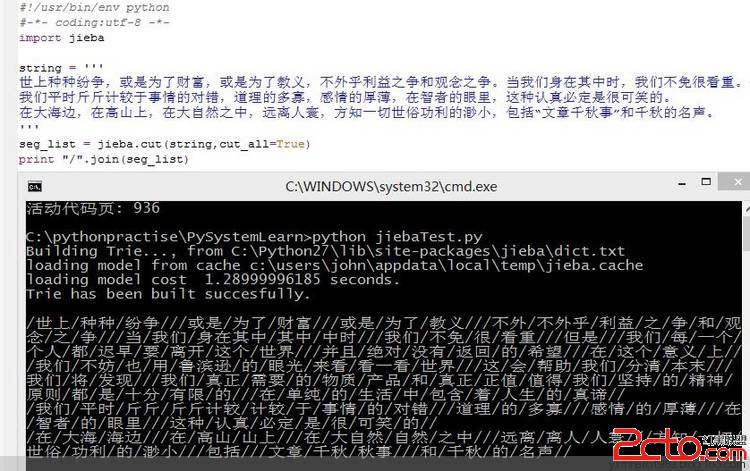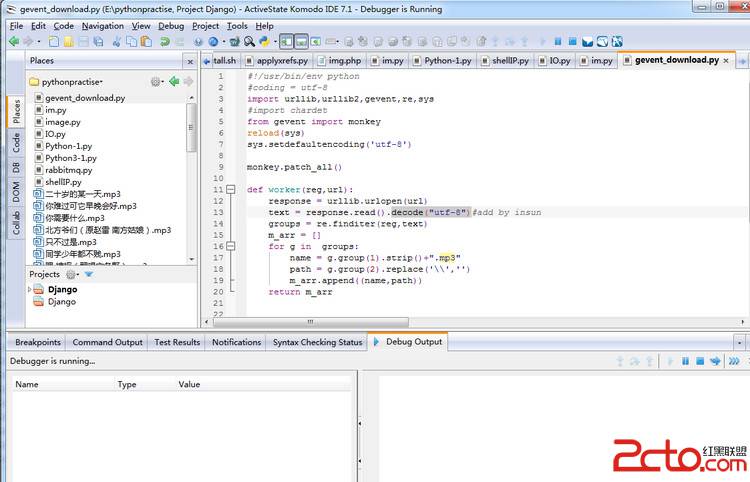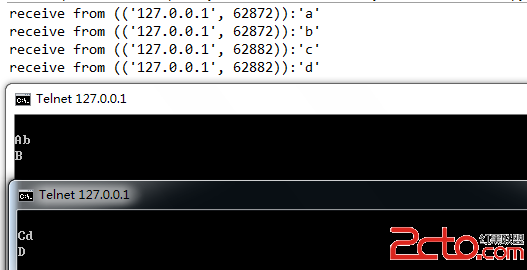python time模块详解(转)
python 的内嵌time模板翻译及说明
一、简介
time模块提供各种操作时间的函数
说明:一般有两种表示时间的方式:
第一种是时间戳的方式(相对于1970.1.1 00:00:00以秒计算的偏移量),时间戳是惟一的
第二种以数组的形式表示即(struct_time),共有九个元素,分别表示,同一个时间戳的struct_time会因为时区不同而不同
year (four digits, e.g. 1998)
month (1-12)
day (1-31)
hours (0-23)
minutes (0-59)
seconds (0-59)
weekday (0-6, Monday is 0)
Julian day (day in the year, 1-366)
DST (Daylight Savings Time) flag (-1, 0 or 1) 是否是夏令时
If the DST flag is 0, the time is given in the regular time zone;
if it is 1, the time is given in the DST time zone;
if it is -1, mktime() should guess based on the date and time.
二、函数介绍
1.asctime()
asctime([tuple]) -> string
将一个struct_time(默认为当时时间),转换成字符串
Convert a time tuple to a string, e.g. ‘Sat Jun 06 16:26:11 1998′.
When the time tuple is not present, current time as returned by localtime()
is used.
2.clock()
clock() -> floating point number
该函数有两个功能,
在第一次调用的时候,返回的是程序运行的实际时间;
以第二次之后的调用,返回的是自第一次调用后,到这次调用的时间间隔
示例:
[python]
<SPAN style="FONT-SIZE: 18px">view plaincopy to clipboardprint<SPAN style="COLOR: #66cc66">?</SPAN>
<SPAN style="COLOR: #ff7700"><STRONG>import</STRONG></SPAN> <SPAN style="COLOR: #dc143c">time</SPAN>
<SPAN style="COLOR: #ff7700"><STRONG>if</STRONG></SPAN> __name__ == <SPAN style="COLOR: #483d8b">'__main__'</SPAN>:
<SPAN style="COLOR: #dc143c">time</SPAN>.sleep(<SPAN style="COLOR: #ff4500">1</SPAN>)
<SPAN style="COLOR: #ff7700"><STRONG>print</STRONG></SPAN> <SPAN style="COLOR: #483d8b">"clock1:%s"</SPAN> <SPAN style="COLOR: #66cc66">%</SPAN> <SPAN style="COLOR: #dc143c">time</SPAN>.clock()
<SPAN style="COLOR: #dc143c">time</SPAN>.sleep(<SPAN style="COLOR: #ff4500">1</SPAN>)
<SPAN style="COLOR: #ff7700"><STRONG>print</STRONG></SPAN> <SPAN style="COLOR: #483d8b">"clock2:%s"</SPAN> <SPAN style="COLOR: #66cc66">%</SPAN> <SPAN style="COLOR: #dc143c">time</SPAN>.clock()
<SPAN style="COLOR: #dc143c">time</SPAN>.sleep(<SPAN style="COLOR: #ff4500">1</SPAN>)
<SPAN style="COLOR: #ff7700"><STRONG>print</STRONG></SPAN> <SPAN style="COLOR: #483d8b">"clock3:%s"</SPAN> <SPAN style="COLOR: #66cc66">%</SPAN> <SPAN style="COLOR: #dc143c">time</SPAN>.clock()</SPAN>
view plaincopy to clipboardprint?
import time
if __name__ == '__main__':
time.sleep(1)
print "clock1:%s" % time.clock()
time.sleep(1)
print "clock2:%s" % time.clock()
time.sleep(1)
print "clock3:%s" % time.clock()输出:
clock1:3.35238137808e-006
clock2:1.00004944763
clock3:2.00012040636
其中第一个clock输出的是程序运行时间
第二、三个clock输出的都是与第一个clock的时间间隔
3.sleep(…)
sleep(seconds)
线程推迟指定的时间运行,经过测试,单位为秒,但是在帮助文档中有以下这样一句话,这关是看不懂
“The argument may be a floating point number for subsecond precision.”
4.ctime(…)
ctime(seconds) -> string
将一个时间戳(默认为当前时间)转换成一个时间字符串
例如:
[python]
<SPAN style="FONT-SIZE: 18px"> <SPAN style="COLOR: #dc143c">time</SPAN>.ctime()</SPAN>
time.ctime()输出为:’Sat Mar 28 22:24:24 2009′
5.gmtime(…)
gmtime([seconds]) -> (tm_year, tm_mon, tm_day, tm_hour, tm_min,tm_sec, tm_wday, tm_yday, tm_isdst)
将一个时间戳转换成一个UTC时区(0时区)的struct_time,如果seconds参数未输入,则以当前时间为转换标准
6.localtime(…)
localtime([seconds]) -> (tm_year,tm_mon,tm_day,tm_hour,tm_min,tm_sec,tm_wday,tm_yday,tm_isdst)
将一个时间戳转换成一个当前时区的struct_time,如果seconds参数未输入,则以当前时间为转换标准
7.mktime(…)
mktime(tuple) -> floating point number
将一个以struct_time转换为时间戳
8.strftime(…)
strftime(format[, tuple]) -> string
将指定的struct_time(默认为当前时间),根据指定的格式化字符串输出
python中时间日期格式化符号:
%y 两位数的年份表示(00-99)
%Y 四位数的年份表示(000-9999)
%m 月份(01-12)
%d 月内中的一天(0-31)
%H 24小时制小时数(0-23)
%I 12小时制小时数(01-12)
%M 分钟数(00=59)
%S 秒(00-59)
%a 本地简化星期名称
%A 本地完整星期名称
%b 本地简化的月份名称
%B 本地完整的月份名称
%c 本地相应的日期表示和时间表示
%j 年内的一天(001-366)
%p 本地A.M.或P.M.的等价符
%U 一年中的星期数(00-53)星期天为星期的开始
%w 星期(0-6),星期天为星期的开始
%W 一年中的星期数(00-53)星期一为星期的开始
%x 本地相应的日期表示
%X 本地相应的时间表示
%Z 当前时区的名称
%% %号本身
9.strptime(…)
strptime(string, format) -> struct_time
将时间字符串根据指定的格式化符转换成数组形式的时间
例如:
2009-03-20 11:45:39 对应的格式化字符串为:%Y-%m-%d %H:%M:%S
Sat Mar 28 22:24:24 2009 对应的格式化字符串为:%a %b %d %H:%M:%S %Y
10.time(…)
time() -> floating point number
返回当前时间的时间戳
三、疑点
1.夏令时
在struct_time中,夏令时好像没有用,例如
a = (2009, 6, 28, 23, 8, 34, 5, 87, 1)
b = (2009, 6, 28, 23, 8, 34, 5, 87, 0)
a和b分别表示的是夏令时和标准时间,它们之间转换为时间戳应该相关3600,但是转换后输出都为646585714.0
四、小应用
1.python获取当前时间
time.time() 获取当前时间戳
time.localtime() 当前时间的struct_time形式
time.ctime() 当前时间的字符串形式
2.python格式化字符串
格式化成2009-03-20 11:45:39形式
[python]
<SPAN style="FONT-SIZE: 18px"> <SPAN style="COLOR: #dc143c">time</SPAN>.strftime(<SPAN style="COLOR: #483d8b">"%Y-%m-%d %H:%M:%S"</SPAN>, <SPAN style="COLOR: #dc143c">time</SPAN>.localtime())</SPAN>
time.strftime("%Y-%m-%d %H:%M:%S", time.localtime())格式化成Sat Mar 28 22:24:24 2009形式
[python]
<SPAN style="FONT-SIZE: 18px"> <SPAN style="COLOR: #dc143c">time</SPAN>.strftime(<SPAN style="COLOR: #483d8b">"%a %b %d %H:%M:%S %Y"</SPAN>, <SPAN style="COLOR: #dc143c">time</SPAN>.localtime())</SPAN>
time.strftime("%a %b %d %H:%M:%S %Y", time.localtime())3.将格式字符串转换为时间戳
[python]
<SPAN style="FONT-SIZE: 18px"> a = <SPAN style=
补充:Web开发 , Python ,




